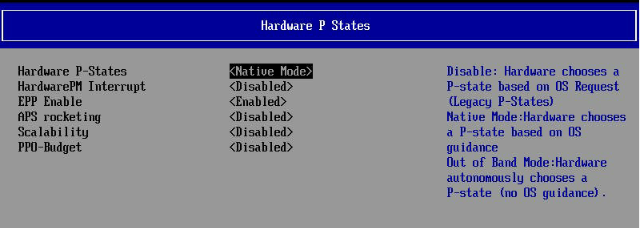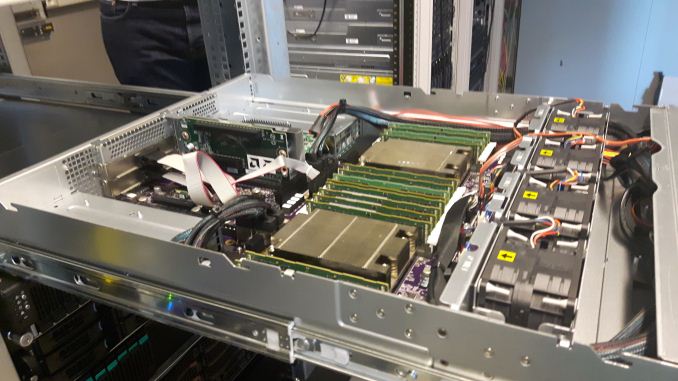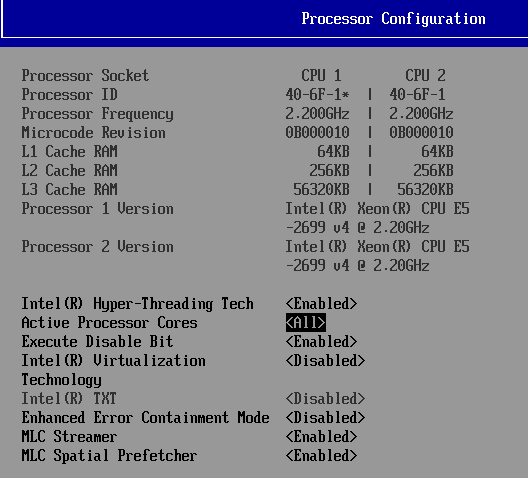Sizing Up Servers: Intel's Skylake-SP Xeon versus AMD's EPYC 7000 - The Server CPU Battle of the Decade?
by Johan De Gelas & Ian Cutress on July 11, 2017 12:15 PM EST- Posted in
- CPUs
- AMD
- Intel
- Xeon
- Enterprise
- Skylake
- Zen
- Naples
- Skylake-SP
- EPYC
Testing Notes
For the EPYC launch, AMD sent us their best SKU: the EPYC 7601. Meanwhile Intel gave us a choice between the top bin Xeon 8180 and the Xeon 8176. Considering that the latter had 165-173W TDP, similar to AMD's best EPYC, we felt that the Xeon 8176 was the best choice.
Unfortunately, our time testing the two platforms has been limited. In particular, we only received AMD's EPYC system last week, and the company did not put an embargo on the results. This means that we can release the data now, in time to compare it to the new Skylake-SP Xeons, however it also means that we've only had a handful of days to work with the platform before writing all of this up for today's embargo. We're confident in the data, but it means that we haven't had a chance to tease out the nuances of EPYC quite yet, and that will have to be something we get to in a future article.
Meanwhile we should note that we've had to retire the bulk of our historical benchmark data, as we upgraded both our compiler and OS (see below). Due to this, we only had a very limited amount of time to run additional systems, and for that reason we've opted include Intel's Xeon E5-2690. The Sandy Bridge-EP processor is about 5 years old, and for customers who aren't upgrading their servers every single generation, it's these servers that we believe are most likely to get upgraded in this round. So for server managers looking at finally buying into new hardware, you can get an idea of much return of investment you get.
Benchmark Configuration and Methodology
All of our testing was conducted on Ubuntu Server "Xenial" 16.04.2 LTS (Linux kernel 4.4.0 64 bit). The compiler that ships with this distribution is GCC 5.4.0.
You will notice that the DRAM capacity varies among our server configurations. The reason is that we had little time left before today's launch embargo. Removing any hardware is always a risk, so we decided to run our tests without significantly changing the internal hardware of the systems we received from AMD and Intel (SSDs were still replaced). As far as we know, all of our tests fit in 128 GB, so DRAM capacity should not have much influence on performance. But it wil have a impact on total energy consumption, which we will discuss.
Last but not least, we want to note how the performance graphs have been color-coded. Orange is AMD's EPYC, dark blue is Intel's best (Skylake-SP), and light blue is the previous generation Xeons (Xeon E5-v4) . Gray has been used for the soon-to-be-replaced Xeon v1.
Intel's Xeon "Purley" Server – S2P2SY3Q (2U Chassis)
| CPU | Two Intel Xeon Platinum 8176 (2.1 GHz, 28c, 38.5MB L3, 165W) |
| RAM | 384 GB (12x32 GB) Hynix DDR4-2666 |
| Internal Disks | SAMSUNG MZ7LM240 (bootdisk) Intel SSD3710 800 GB (data) |
| Motherboard | Intel S2600WF (Wolf Pass baseboard) |
| Chipset | Intel Wellsburg B0 |
| BIOS version | 9/02/2017 |
| PSU | 1100W PSU (80+ Platinum) |
The typical BIOS settings can be seen below; we enabled hyperthreading and Intel virtualization.
AMD EPYC 7601 – (2U Chassis)
Five years after our "Piledriver review", a new AMD server arrives in the Sizing Servers Lab.
| CPU | Two EPYC 7601 (2.2 GHz, 32c, 8x8MB L3, 180W) |
| RAM | 512 GB (16x32 GB) Samsung DDR4-2666 @2400 |
| Internal Disks | SAMSUNG MZ7LM240 (bootdisk) Intel SSD3710 800 GB (data) |
| Motherboard | AMD Speedway |
| BIOS version | To check. |
| PSU | 1100W PSU (80+ Platinum) |
Intel's Xeon E5 Server – S2600WT (2U Chassis)
| CPU | Two Intel Xeon processor E5-2699v4 (2.2 GHz, 22c, 55MB L3, 145W) Two Intel Xeon processor E5-2690v3 (2.3 GHz, 14c, 35MB L3, 120W) |
| RAM | 256 GB (16x16GB) Kingston DDR-2400 |
| Internal Disks | SAMSUNG MZ7LM240 (bootdisk) Intel SSD3700 800 GB (data) |
| Motherboard | Intel Server Board Wildcat Pass |
| BIOS version | 1/28/2016 |
| PSU | Delta Electronics 750W DPS-750XB A (80+ Platinum) |
The typical BIOS settings can be seen below.
HP-G8 (2U Chassis) - Xeon E5-2690
| CPU | Two Intel Xeon processor E5-2690 (2.9GHz, 8c, 20MB L3, 135W) |
| RAM | 512 GB (16x32GB) Samsung DDR-3 LR-DIMM 1866 MHz @ 1333 MHz |
| Internal Disks | SAMSUNG MZ7LM240 (bootdisk) Intel SSD3700 800 GB (data) |
| Motherboard | HP G8 |
| BIOS version | 9/23/2016 |
| PSU | HP 750W (Gold) |
Other Notes
Both servers are fed by a standard European 230V (16 Amps max.) power line. The room temperature is monitored and kept at 23°C by our Airwell CRACs.














219 Comments
View All Comments
twtech - Thursday, July 20, 2017 - link
I'd really like to see some compile-time benchmarks for these CPUs.For my own particular interests, time taken to do a full recompile of the Unreal 4 engine from source would be very useful. But even something more generic like the Linux kernel compiles per hour benchmark could serve as a useful point of reference.
szupek - Friday, July 21, 2017 - link
Meanwhile, the entire world still runs on IBM's DB2 for Datbases and IBM's Z/AS400 Mainframes. The fastest database in the world, by far...oh and the most secure (it's only hackable by standing in front of the console, seriously). Every single credit card transaction. Every single plain ticket. Most medical records and all of wall street. Yup. IBM still owns. So much that most of commenters probably have no idea just how big IBM truly is. If you care about Database speed & security, these processors shouldn't appeal to you.stevefan1999 - Saturday, July 22, 2017 - link
It's impossible for AMD to win completely.Remember kids, public cloud service providers such as Amazon(AWS), Google(GCP) and Joyent would still stick with Intel due to not only the compatibility issues like ecosystem and vendor inconsistency, but also the VM migration and security and module issues, all mentioned in the presentation slides presented by Intel. They are a very serious matter, as they, the public cloud services, are powering the Internet we use everyday, so being stable, consistent and be able to serve a good amount of SLA is vital to the public cloud, we wouldn't expect them to play with the new lad in the hood, the EPYC.
IIRC only the Microsoft(Azure) are using AMD server CPUs partially in some of their datacenters, running various Linux and Windows VMs using Hyper-V, and they have been performing quite well
The cloud services are exploding every year, but with what I've said, I doubt AMD could even kick in the first door at least for 3 to 4 years. This is still a big-win for Intel and what manipulations will Intel do I don't know.
On the other hand, Intel has failed to service the desktop market and they're figuring out how to hold their asses on the Internet infrastructure, never had them know the crusade of EPYC will come this fast.
The server market is quite a big meat, it's a 21 bil market, cool right? But that you will have guaranteed 'server upgrade' every year, is a bigger matter, as those server CPUs are designated to be disposed given the wattage and performance per dollar is lower on the newer CPUs. Those god-damn server operators will keen to replace their CPU (and therefore some serious metal pollution issues). Intel has been exploiting this and gained a big hurdle of money and therefore had their ecosystem grown. This is how Intel defends their platform by vendor lock-in, pathetic.
AMD is now being performance and cost competitive to Intel, but it's still dead in the High Performance Computing campaign unless AMD could provide higher frequencies. Well I have to say I know nothing about HPC, but I remembered the Bulldozer architecture of AMD is actually targeted and marketed for HPC! That's why AMD failed in general-purpose computing market and started the downfall of AMD/Domination of Intel 5 years ago. Even though we know the fate of Bulldozer, but hopefully AMD could still scrap some of the HPC goodies of Bulldozer out and benefits the mankind by accelerating researches such as finding the cures for cancer or solving some precise physics and mathematics.
Well, anyway the cloud, the HPC and the server market are the last resort for Intel and they will definitely hold their last ground. Good luck AMD on crushing the mean and obese Intel!
errorr - Sunday, July 23, 2017 - link
For all the talk about speed and efficiency the problem is about $$$. The sad fact is that what matters most isn't even the price of the cpus which is chump change in the grand scheme of things but how the software licensing costs are determined. Per core or per socket software pricing will matter a lot. The software companies will decide how successful EPYC is. I have a feeling they will be biased slightly toward AMD at the beginning as it is in their interest to foster competition for Intel, or if they are not forward looking enough the end customers might argue that the competition will benefit the SW companies in the long run by continuing to push competition.msroadkill612 - Thursday, July 27, 2017 - link
Whatever, its all pointless if the competition can read your secrets, which is a matter very close to the hearts of the cheque signers.AMD seem to have something very superior to offer in that department.
qweqwe - Tuesday, August 8, 2017 - link
we just did some heavy inhouse hpc-tests with epyc against diff. intel servers.the epyc is the clear winner in terms of performance and power consumption when it
comes to hand-tuned parallel-vector-code examples.
not bad amd !
readonly1 - Friday, October 27, 2017 - link
qweqwe, I totally agree with you. Our inhouse HPC tests get the similar conclusion, after comparing AMD Epyc 7351 (dual socket, 32 cores, 2400Mhz) and Intel SKylake 6154 (dual socket, 36 cores, 3000Mhz). I think AMD clearly wins in the memory bandwidth, which is extremely important for HPC computation.msroadkill612 - Monday, November 13, 2017 - link
7/11/2017 "Microsoft is already deploying AMD's EPYC in their Azure Cloud Datacenters."Interesting. As i have been theorising, a possible reason for the absence of retail epyc is not supply, but demand.
A single sale can soak up production runs.
If so tho, not much sign of big revenues from it yet, but there are other explanations for that. Contra processors for development work e.g.
q.epsilon.p - Sunday, June 10, 2018 - link
power consumption numbers with every benchmark would have been nice, because these parts are server benchmarks, Perf / Watt is one of the primary concerns. And where AMD kinda crush Intel, because it's isn't exactly being honest with it's TDP values nowadays when it comes to Data Centre and HEDT.TDP was traditionally the absolute maximum the CPU would put out as heat, now with a power consumption of 670W I am assuming that the heat being put out by the CPU is more than 165W.